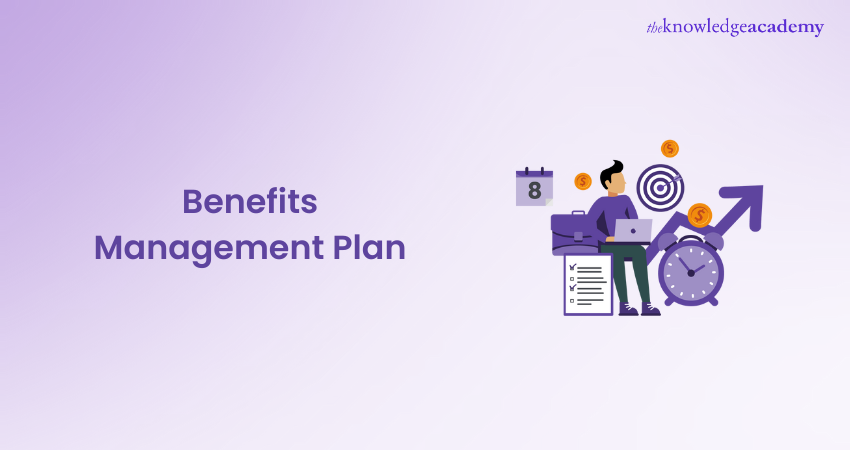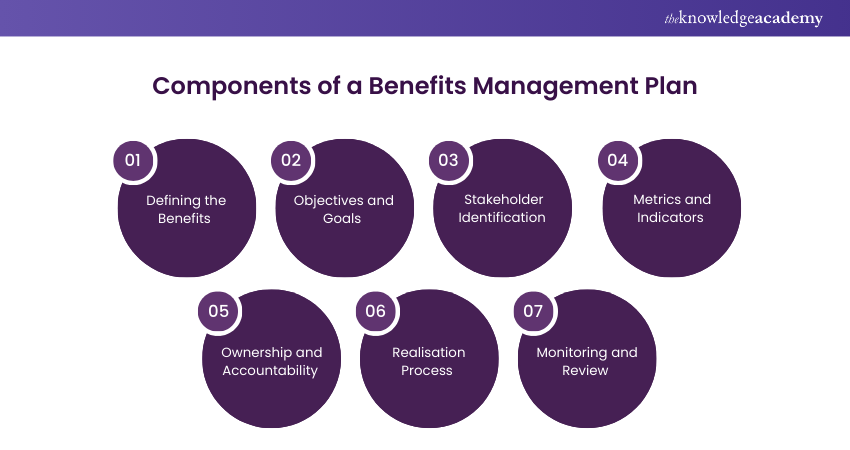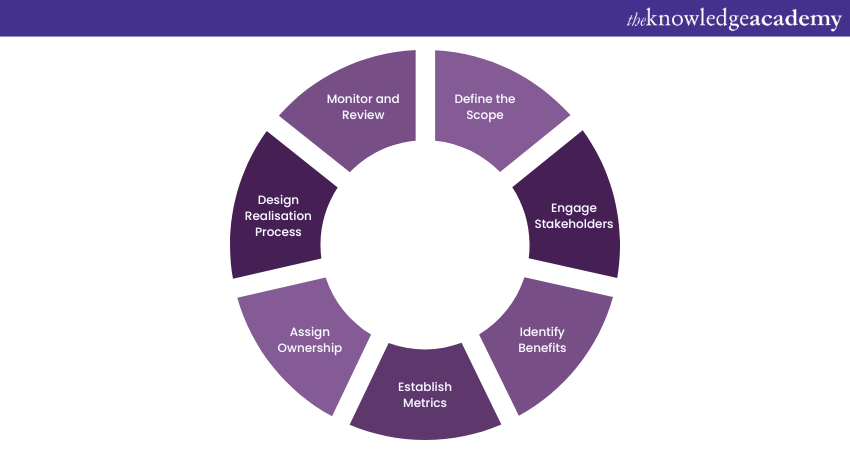We may not have the course you’re looking for. If you enquire or give us a call on +44 1344 203 999 and speak to our training experts, we may still be able to help with your training requirements.
We ensure quality, budget-alignment, and timely delivery by our expert instructors.

A Benefits Management Plan is paramount to every modern-day organisation, that wants to manage and maximise project benefits effectively. By outlining the strategies and actions required to identify, measure, and realise project benefits, a Benefits Management Plan ensures that organisations achieve their desired outcomes and optimise their investments. Discover how a Benefits Management Plan can help you achieve your project goals and business vision. Learn the best practices and strategies for Benefits Management through our blog.
Table of Contents
1) What is a Benefits Management Plan?
2) What Does a Benefits Management Plan Include?
3) Top 7 Components of a Benefits Management Plan
4) How to Develop a Benefits Management Plan?
5) Conclusion
What is a Benefits Management Plan?
A Project Benefits Management Plan (PBMP) is a document that details how a project’s benefits will be achieved and managed. It outlines the expected benefits, the approach to realising them, and the methods for measuring and tracking these benefits. Additionally, the PBMP includes a communication plan for informing stakeholders, including project team members, and customers, about the benefits.
Projects can yield various types of benefits, such as reducing business costs through automation, boosting corporate sales with new and advanced products, and complying with statutory or regulatory requirements. A structured approach ensures that investments yield benefits, emphasising the importance of stakeholder engagement in this process. The Benefits Management Plan is regularly reviewed throughout the project to ensure that the anticipated benefits are on track for delivery.
The PBMP is used to ensure that a project’s benefits are realised and sustained. It is a living document, updated frequently to reflect changes in the project and business environment, and is used throughout the project life cycle—from initiation to closeout—to help ensure that the benefits are achieved and maintained.
What does a Benefits Management Plan include?
A Benefits Management Plan is a guide, which outlines potential benefits to be achieved as well as the value of a given project or agenda. It is useful in the sense that it assists in making sure that the expected benefits of the project are achieved, to fit the goals of the organisation. A Benefits Management Plan should cover the following aspects for each benefit:A Benefits Management Plan should cover the following aspects for each benefit:
a) Description: Short and concise description of the benefit with reference to how it enhances the success of the organisation.
b) Timeline: A plan that indicates the time frame within which the benefit will be given to the organisation and when it will be appreciated and how this can be checked as well as making sure that the process is checked from time to time.
c) Beneficiaries: An identification of the consumers and other stakeholders who will be benefited when the project is accomplished together with their functions.
d) Measurement: The need to define the indicators and methods that will be used to measure the benefit and the current and target values in particular.
e) Risks: Using a SWOT study, the opportunity they may be faced with that are likely to impact on the benefit realisation the risk and the measures put in place.
Unlock the full potential of Benefits Management with our Managing Benefits Foundation Course. Join today!
Top 7 Components of a Benefits Management Plan

There are several aspects that you must consider while creating effective Business Management Plan:
1) Defining the Benefits
This component presents the expected output and the utility that comes with it and how the component aligns with the organisational strategy. For instance, a benefit could be the enhancement of customers’ satisfaction, decrease in costs or an improvement in efficiency. The business benefits that should be offered should be clear, tangible, achievable and in support of the organisational vision and goals. It is useful to note that a clear specification of benefits serves as a starting point in benefit realisation.
2) Objectives and Goals
This element provides description of the context of the plan, that is the reason why it is being prepared, the part of an organisation it shall cover and the time frame within which the plan shall have been achieved alongside with the overall objectives of the plan. For instance, one of the objectives could be customer retention, which should be improved by 10% in one year. Targets and targets should be specific, measurable attainable, realistic, time-bound (SMART) and must supplement the target objectives of the project. For example a clear statement of objectives and goals can help in the steering and formatting of the plan.
3) Stakeholder Identification
This component establishes the responsibilities of the various stakeholders of the project and the plan and also defines them. For instance, the stakeholder could be the customer, the employee, the manager or the supplier among others. Stakeholder identification enables one to know the various groups’ desires, expectations and concerns as well as involve them in the realisation of the benefits. This can be done using the stakeholder analysis matrix to identify the stakeholder and their power /interest.
4) Metrics and Indicators
This component also identifies the means and ways of how the benefits are to be assessed and/or measured such as base and target values. For instance, a metric could be the survey results whereas an indicator could be the rating by the customer being excellent or good. Such measures and markers enable one to measure the returns, and evaluate the effectiveness and achievement of the strategy. It is possible to map the benefits, metrics and the indicators to the project’s deliverable and results by use of benefits map.
5) Ownership and Accountability
This component assigns benefit owners responsible for delivering and realising the benefits, along with reporting and governance mechanisms. A well-defined Benefits Management Job Description clarifies these responsibilities. A RACI matrix can assign Responsible, Accountable, Consulted, and Informed parties for each benefit.
6) Realisation Process
This component describes the activities and actions required to achieve and sustain the benefits, including planning, delivery, transition, and review stages. For example, an activity could be conducting a benefits review workshop, and an action could be implementing a feedback system. The realisation process outlines the steps and tasks involved in delivering and sustaining benefits within the organisation. A benefits realisation plan can document the process and schedule.
7) Monitoring and Review
This component outlines the process of tracking and reporting the plan’s progress and performance, identifying and managing any issues or risks that may affect benefit realisation. For example, a process could involve using a benefits dashboard, and a risk could be a change in customer preferences. Monitoring and review ensure benefits are achieved and maintained, addressing any deviations or challenges. A benefits register can record benefits, their status, and any issues or risks.
Elevate your Benefits Management skills to the next level with our Managing Benefits™ Foundation & Practitioner. Sign up now!
How to Develop a Benefits Management Plan?

To develop a comprehensive Benefits Management Plan, organisations should follow a structured approach that encompasses the following steps:
1) Define the Scope
Clearly define the scope of the Benefits Management Plan, detailing the projects or initiatives included and the expected outcomes. This helps establish boundaries and clarifies focus areas.
2) Engage Stakeholders
Involve key stakeholders in the planning process to secure their buy-in, input, and insights. Collaboration ensures that stakeholders’ expectations are addressed and their perspectives are integrated into the plan.
3) Identify Benefits
Identify and thoroughly document all potential benefits associated with the project. Analyse each benefit to determine its alignment with organisational objectives and feasibility.
4) Establish Metrics
Create specific, measurable metrics and KPIs to track and assess the progress of benefit realisation. These metrics should be relevant, achievable, and time-bound.
5) Assign Ownership
Assign responsibility for each benefit to a dedicated benefit owner. These individuals should have the necessary authority, resources, and expertise to ensure successful outcomes.
6) Design Realisation Process
Develop a detailed implementation plan summarising the specific activities, resources, timelines, and dependencies required to achieve the identified benefits. This plan should be realistic, adaptable, and aligned with overall project goals.
7) Monitor and Review
Continuously monitor the progress of benefit realisation activities and regularly review outcomes. This approach allows organisations to identify deviations, assess the effectiveness of the plan, and make necessary adjustments.
Conclusion
A well-structured Benefits Management Plan is essential for organisations to maximise the value derived from their projects and initiatives. By following the outlined components and best practices, organisations can effectively identify, measure, track, and realise the benefits that align with their strategic objectives. With a robust plan in place for Benefits Management, organisations can optimise their investments and achieve their desired outcomes.
Enhance your strategic capabilities with our comprehensive Managing Benefits Training Courses. Join today for long-term success!
Frequently Asked Questions
What Does a Benefits Specialist Manager do?

A Benefits Specialist Manager designs, implements, and manages employee benefits programmes, including health insurance, pension plans, and wellness initiatives. They ensure compliance with regulations, analyse benefits trends, and collaborate with providers to optimise offerings, enhancing employee satisfaction and retention.
How Can Organisations Effectively Integrate a Benefits Management Plan into their Project Management Framework?

Organisations can integrate a Benefits Management Plan into project management by following a structured process: defining, planning, delivering, transitioning, and reviewing benefits. Tools like benefits maps, registers, dashboards, and stakeholder analysis matrices support integration across the project lifecycle.
What Are the Other Resources and Offers Provided by The Knowledge Academy?

The Knowledge Academy takes global learning to new heights, offering over 3,000 online courses across 490+ locations in 190+ countries. This expansive reach ensures accessibility and convenience for learners worldwide.
Alongside our diverse Online Course Catalogue, encompassing 19 major categories, we go the extra mile by providing a plethora of free educational Online Resources like News updates, Blogs, videos, webinars, and interview questions. Tailoring learning experiences further, professionals can maximise value with customisable Course Bundles of TKA.
What is The Knowledge Pass, and How Does it Work?

The Knowledge Academy’s Knowledge Pass, a prepaid voucher, adds another layer of flexibility, allowing course bookings over a 12-month period. Join us on a journey where education knows no bounds.
What are The Related Managing Benefits Courses and Blogs Provided by The Knowledge Academy?

The Knowledge Academy offers various Managing Benefits™ Training, including the Managing Benefits Foundation and Practitioner courses. These courses cater to different skill levels, providing comprehensive insights into Benefits Management.
Our Business Skills Blogs cover a range of topics related to Benefits Management, offering valuable resources, best practices, and industry insights. Whether you are a beginner or looking to advance your Business skills, The Knowledge Academy's diverse courses and informative blogs have got you covered
Upcoming Business Skills Resources Batches & Dates
Date
 Managing Benefits™ Foundation
Managing Benefits™ Foundation
Mon 14th Apr 2025
Mon 16th Jun 2025
Mon 11th Aug 2025
Mon 1st Dec 2025






 Top Rated Course
Top Rated Course



 If you wish to make any changes to your course, please
If you wish to make any changes to your course, please


